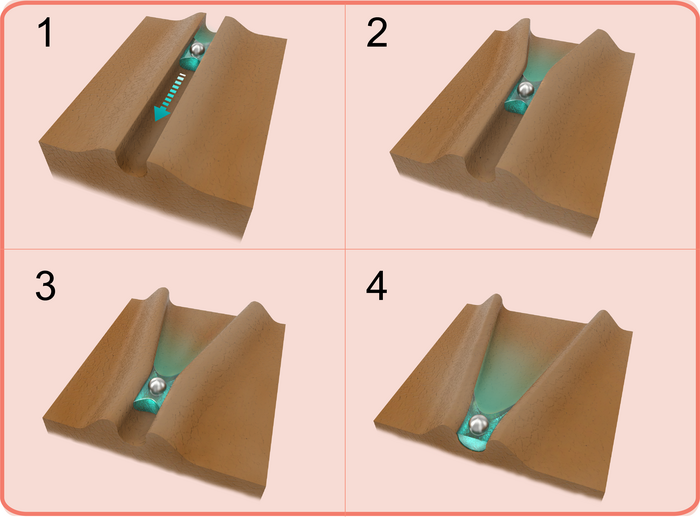Investigators from NYU Abu Dhabi’s Smart Materials Lab (SML) and Center for Smart Engineering Materials (CSEM) have developed an innovative method of harvesting water from naturally occurring sources like fog and dew.

The particles on the crystalline surface are picked up by water and carried down the channel as the channel sublimes and widens. Image Credit: New York University Abu Dhabi.
Water spontaneously condensing from vapor to liquid form and moving across the surface of a gradually subliming organic crystal was observed for the first time in the study by Research Scientist Patrick Commins and Post-doctoral Associate Marieh B. Al-Handawi. This was discovered to be induced by the alteration of the width of small channels that appear on the crystal’s surface over time and guide condensed water across the surface.
Investigators reported the condensation and water movement that transports particles on the surface of crystals of hexachlorobenzene, a widely used fungicide. The surface of this material has a rigid topography with defined parallel channels due to sublimation.
Small solid particles, like dust or metallic nanoparticles, were seen moving autonomously through the channels. The movement of these particles was discovered to be caused by condensed aerial water, which moves through the channels as the cross-section and width of the channels change over time.
The research was published in the journal Nature Chemistry.
Autonomous water flow has previously been attained on the surface of natural systems like certain plants or insects, using either surface chemical modifications or accurately fabricated microchannels. The observations of this new study have the potential to guide the development of new technologies to utilize naturally occurring sources of water like dew and fog, which are currently used for survival by only a few desert plants and animals.
The new study contributes to the understanding of the water collection mechanisms of such biological structures while presenting a fundamentally different water transportation mechanism.
The motion of water on solid surfaces is one of the most fundamental phenomena found in nature. Through millennia-long evolutionary processes, surfaces of natural organisms have been optimized for efficient transport of water for a variety of life-supporting functions. Plants have been seen to do this by moving water against gravity.
Panče Naumov, Study Corresponding Author and Director, Center for Smart Engineering Materials
Panče Naumov, who is also the leader of the Smart Materials Lab, adds, “Our team has discovered a new way to move water across a dynamic solid surface, a fundamentally new underlying principle of water collection. This can provide an inspiration for emerging technologies that could potentially maximize the efficiency of experimental systems used for the collection of aerial humidity.”
Journal Reference
Commins, P., et al. (2023). Autonomous and directional flow of water and transport of particles across a subliming dynamic crystal surface. Nature Chemistry. doi.org/10.1038/s41557-023-01158-5.